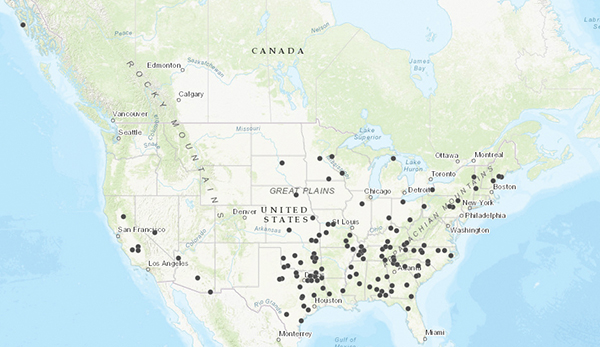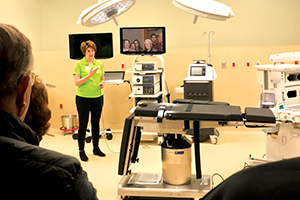By LISA EISENHAUER
PHOENIX — Shrinking populations, the shift from inpatient to outpatient care, and the refusal by some states to expand Medicaid are among the challenges that researchers link to a wave of rural hospital closures, including 19 last year.

A map created by the North Carolina Rural Health Research Program shows where 166 rural hospitals have closed since 2005.
Ideas for confronting and withstanding those forces were in the spotlight at the American Hospital Association's Rural Health Care Leadership Conference in February in Phoenix.
"For all our rural hospitals and health systems, regardless of how they are positioned, these challenges are not only creating financial instability, but affecting the economic health of the entire community," Dr. Melinda L. Estes, chairwoman of the American Hospital Association's board of trustees, said at the start of the conference. CHA and Mercy Virtual, a subsidiary of Chesterfield, Missouri-based Mercy health, were among the sponsors of the four-day event, which drew more than 1,100 people.

Nicole Gerleman, surgery coordinator at Avera Merrill Pioneer Hospital, talks to visitors touring the operating room during the public grand opening last spring for the new hospital in Rock Rapids, Iowa. Some of the guests are reflected in the monitor behind her. The town has a population of about 2,500 and is the county seat of Lyon County, which has a population of about 11,800.
Estes, president and chief executive of Kansas City, Missouri-based Saint Luke's Health System, pointed out that rural hospitals — defined as those outside of metropolitan statistical areas — serve as the main source of health care for 20 percent of the nation's population and often are a main employer in small communities.
Economic anchors
A study published in 2006 in the journal Health Services Research confirms the strong local economic role of rural hospitals. The study found that, on average, the closure of the sole hospital in a rural county reduced per capita income by $703 or 4% and increased the unemployment rate by 1.6%.
Since 2005, many communities have suffered that economic blow, with 166 rural hospitals shuttering, according to the North Carolina Rural Health Research Program at the University of North Carolina at Chapel Hill. The largest number of closures in one year during that period was the 19 in 2019. In the first few weeks of 2020, four more rural hospitals locked up.
The rural health research program at the university's Cecil G. Sheps Center for Health Services Research cites several reasons for the closures, including:
- Population losses that decrease the market for health care.
- Hospital and health system mergers that create referral patterns that exclude rural hospitals.
- Government policies, such as states refusing to expand Medicaid coverage under the Affordable Care Act.
- Technology advances that allow many services to be delivered on an outpatient basis.
A 2018 report on rural hospital closures by Congress' nonpartisan Government Accountability Office cites similar woes and causes. The report says the hospitals' financial distress "has been exacerbated in recent years by multiple factors, including the decrease in patients seeking inpatient care and across-the-board Medicare payment reductions." It noted that more rural hospitals closed in states that declined to increase Medicaid eligibility and enrollment under the ACA.
Supporting Medicaid expansion
Brandtley Adams is executive director of regional outreach and administrative special projects at Tulsa, Oklahoma-based Saint Francis Health System. He said Saint Francis supports a Medicaid expansion effort underway in Oklahoma. Backers of the initiative have turned in petitions with enough signatures to trigger a statewide vote on expanding Medicaid under the ACA and are now waiting for the governor to decide when the measure will go on the ballot.

Adams
"We believe that the increased funding for this sort of gap population that isn't currently covered under the state's Medicaid program will help keep these rural hospitals open," said Adams, who attended the Rural Health Care Leadership Conference. Oklahoma ranks third in rural hospital closures with nine since 2005, behind Texas, which had 24 hospital closures, and Tennessee, which had 13.
Saint Francis Health System bought a struggling hospital in Muskogee, Oklahoma, in 2016. Adams said the hospital is now financially stable. He credits that to investments the system made to upgrade the facility and better align its services to community needs. One change, for example, was to renovate its outdated behavioral health care unit.
As some of the speakers at the conference pointed out, aligning with larger hospitals or health systems is one of the options that have helped save some rural hospitals. Another helpful step they mentioned has been for hospitals to join accountable care organizations, a network in which Medicare providers can coordinate care and reimbursements.
Getting a new start
Craig Hohn, chief executive at Avera Merrill Pioneer Hospital, said some of the concerns plaguing other rural hospitals were addressed during the planning stages for his hospital in Rock Rapids, Iowa, which opened last May.

Hohn
The hospital, part of the Avera Health system, replaced a decades-old one that largely focused on inpatient care for the community of about 2,500 in the northwestern corner of Iowa. "We actually built the new facility to be much more robust in the outpatient and clinic areas," said Hohn, who attended the Phoenix conference.
The new hospital has only 11 staffed inpatient beds, three fewer than the old one. In addition, the hospital's clinic offers well-used services that had not been available on-site at the old hospital, such as 3D mammography, bone-density scanning and chemotherapy and infusion.
Hohn said his hospital also has the advantage of being in an area that is growing, thanks largely to its proximity to booming Sioux Falls, South Dakota, about 30 miles away. About half its patients have private insurance, a higher percentage than that of many other rural hospitals.
Even with its advantages, Hohn said his hospital is not immune from the pressures most small-town hospitals face. This includes those that relate to government policy such as the amount paid for Medicaid reimbursement.
Agenda for change
The American Hospital Association has crafted a "2020 Rural Advocacy Agenda" that urges several changes from policymakers. One proposal calls for new payment and delivery models to support rural health care. A specific request is for the federal government to create a "Rural Emergency Hospital" designation under the Medicare program to "allow existing facilities to meet a community's need for emergency and outpatient services without having to provide inpatient care."
The agenda also calls out Medicare and Medicaid for paying what the association says is less than 90 cents for each $1 that hospitals and health systems spend on care for patients insured by those programs. "Given the persistent and emergent challenges of providing care in rural areas, reimbursement rates across payers need to be updated to cover the cost of providing care," the agenda says.
Kathy Curran, CHA's senior director of public policy, said the association is aware of the "enormous challenges" rural hospitals face and the need for relief. "CHA supports efforts to improve rural reimbursement by allowing more facilities to become critical access hospitals, to provide funding to address the rural health care workforce shortage and to expand the use of telehealth services in rural areas," Curran said.
Continuing distress
A report released in February by the Chartis Center for Rural Health, run by the hospital advisory firm the Chartis Group, adds urgency to the need for increased government support for rural hospitals. The report found that of the about 1,840 rural hospitals still in operation nationwide, 453 are at risk of going under based on nine variables that the report calls "statistically relevant in determining the probability of closure," including the proportion of outpatient to inpatient revenue and their occupancy rates.
"As policymakers and rural health advocates work to stabilize the rural health safety net, questions inevitability arise with regard to how many hospitals may be forced to confront difficult decisions about maintaining operations," the report said. "This research suggests that a sizeable portion of the country's rural hospitals are vulnerable to closure."